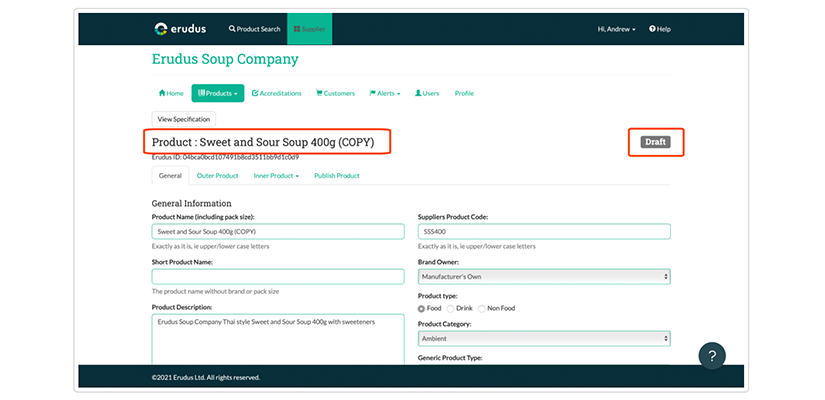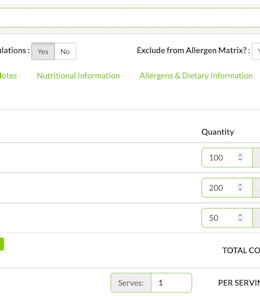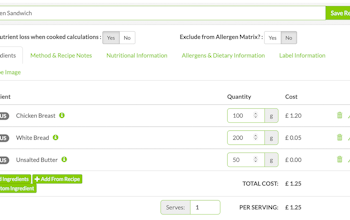Product Names

Shakespeare’s Juliet may have not paid much importance to names, but when it comes to the food industry, product names are nothing short of critical significance.
Why? Because it is the initial factor in consumer choice, the first impression given to a potential buyer. It should provide a short explanation of the food, and because of this, there are specific rules on how products must be named.
The Food Information to Consumers (FIC) identifies 3 types of names:
- Legal names
- Customary names
- Descriptive names
To ensure a product is legally compliant, it must have been named using one of the above.
If you don’t know what each of these names entails don’t worry, Erudus is on hand with our guide to these different product names and the rules behind them...
Legal names
A legal name is the name prescribed for a food by specific EU legislation applying to it - e.g. 'milk chocolate', 'pangasius catfish' or 'instant coffee'.
According to FIC: “The name of the food shall be its legal name. In the absence of such a name, the name of the food shall be its customary name, or, if there is no customary name or the customary name is not used, a descriptive name of the food shall be provided.”
For example, you must call your product ‘instant coffee’ if it:
- Is solid coffee extract, such as coffee granules
- Contains at least 95% coffee
- Contains only natural substances created during the coffee extraction process
A product cannot be called ‘instant coffee’ unless it meets these conditions.

There are some foods that are protected and cannot be used unless the product meets very specific conditions. This list of protected names can be found here.
Customary names
Customary names are names that gradually become so familiar that they are accepted by consumers in the UK (or different areas of the UK) without needing further explanation. For example, Bakewell tart, Yorkshire pudding or fish fingers.
To become customary, such a name will be used consistently (in the same format) for a number of years. There is currently no official list of customary names, and therefore whether a specific name has reached a customary status is a matter of perception.
If alternative ingredients are used within a customary named product that differ from what is typically expected by consumers a clear reference to the change should be made, with clear reference to the differing ingredient within the product name, or alternatively by stating the ingredient close to the product’s name on the label.
For example, if a pesto sauce is made using parsley instead of basil (the traditional ingredient), the product must either be called ‘parsley pesto sauce’ or have the ingredient ‘parsley’ shown directly under or next to the product name.

As customary names are largely down to perception, it is possible for them to go out of fashion - meaning it is no longer sufficiently meaningful on its own. A classic example of this would be ‘'Mississippi mud pie'.
Please note: Again, a customary name going out of fashion is also a matter of perception.
Descriptive Names
If a product has no legal name, and a customary name doesn’t exist, a descriptive name must be given accordingly.
A descriptive name describes what the product is, for example, ‘Macaroni in a cheese sauce’.
The name should be clear and not misleading in any way, to ensure the product can be clearly distinguished from others that it could be confused with.
If a descriptive name is used, the main ingredients should be listed within the name, alongside any information of the food’s structure that clarifies what the product is.
Erudus Product Names and Short Product Names
When copying a published Erudus specification into draft, the word ‘COPY’ will automatically be added to the end of the product name.
It is important to remove this from the name prior to publishing that product,. For more information on copying a product specification to a new draft, please visit the ‘Copying a Product Specification’ article on the Erudus Knowledge Base.

In September 2021 Erudus launched the new ‘Short Product Name’ field - an addition to the ‘Product Name (including pack size)’ field.
The Short Product Name should be the name of the product without branding or pack size information. For example, ‘Raspberry Cheesecake 4 x 100g’ would be ‘Raspberry Cheesecake’.
This field was introduced to make the way products are listed in solutions powered by the Erudus Data Pool (including the Erudus Recipe Builder) more efficient.
When publishing your Erudus specification, you need to make sure:
- An appropriate short product name is present
- If copied from an already published specification, the phrase ‘COPY’ has been removed from the product name
- A spell check has been performed




